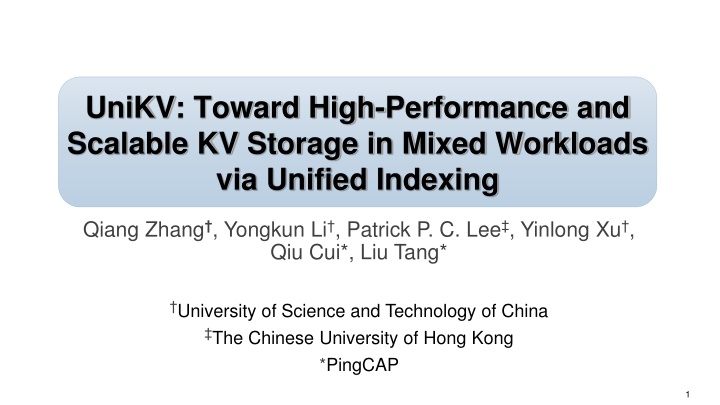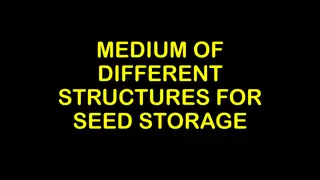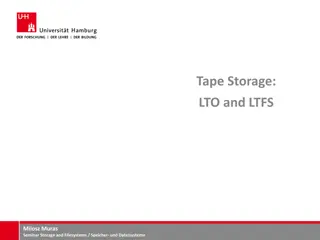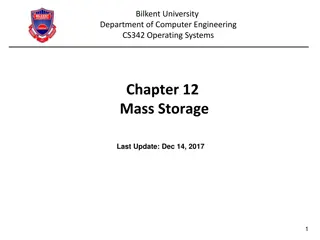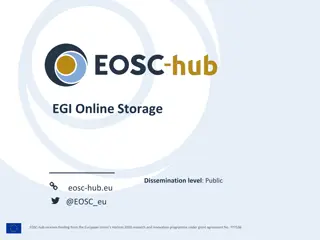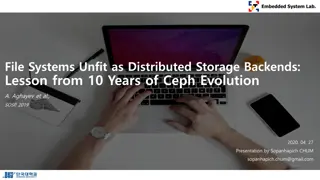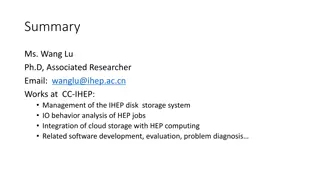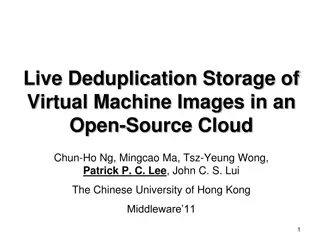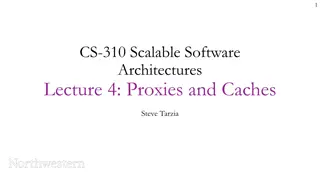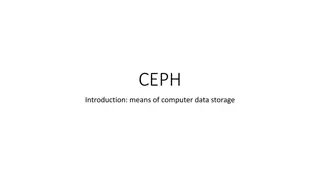UniKV: Toward High-Performance and Scalable KV Storage
The research explores unified indexing for key-value storage to address limitations in LSM-tree designs by combining hash-based efficiency with LSM-tree scalability for improved read, write, and scan performance in mixed workloads.
Download Presentation

Please find below an Image/Link to download the presentation.
The content on the website is provided AS IS for your information and personal use only. It may not be sold, licensed, or shared on other websites without obtaining consent from the author.If you encounter any issues during the download, it is possible that the publisher has removed the file from their server.
You are allowed to download the files provided on this website for personal or commercial use, subject to the condition that they are used lawfully. All files are the property of their respective owners.
The content on the website is provided AS IS for your information and personal use only. It may not be sold, licensed, or shared on other websites without obtaining consent from the author.
E N D
Presentation Transcript
UniKV: Toward High-Performance and Scalable KV Storage in Mixed Workloads via Unified Indexing Qiang Zhang , Yongkun Li , Patrick P. C. Lee , Yinlong Xu , Qiu Cui*, Liu Tang* University of Science and Technology of China The Chinese University of Hong Kong *PingCAP 1
Background Data volume is growing exponentially 33 ZB in 2018 44 ZB in 2020 175 ZB in 2025[1] Various data types (structured, semi-structured and unstructured) Key-value (KV) stores are widely used in many applications Flexible data model & high scalability Cassandra @ Apache RocksDB @ Facebook LevelDB @ Google [1] Internet Data Center, Nov 2018, https://www.idc.com/. 2
Background The most common design of KV stores is based on LSM-tree Immutable MemTable MemTable <key, value> Multiple levels memory disk flush Log Log-structured writes Lowest level compaction kv pairs L0 Sorted in each level bloom filter L1 data index Footer SSTable L2 Efficient writes, scans & high scalability Highest level L6 3
Background Limitations of LSM-tree Large read amplification (RA) and write amplification (WA) RA: up to ~300X; WA: up to ~20X 4
Related Work LSM-tree-based designs exhibit trade-offs Fragmented LSM-tree[1] Relaxes the fully sorted nature in each level Increases write performance, but sacrifices read performance Trie-like structure[2] Hash-based design Good for point query & write, but not support scan KV separation[3] Separates the storage of keys and values Reduces write amplification, incurs extra lookup & high GC cost [1] Raju et al., Pebblesdb: Building key-value stores using fragmented log-structured merge trees , SOSP 17. [2] Wu et al., Lsm-trie: An lsm-tree-based ultra-large key-value store for small data , ATC 15. [3] Lu et al., WiscKey: Separating Keys from Values in SSD-Conscious Storage , FAST 16. 5
Motivation Observation: Indexes possess trade-offs, so single index is hard to meet all performance requirements Hash-based Design Efficient read/write (for small data size) Bad scalability Not support scan High memory usage LSM-tree-based Design Good scalability Efficient scan Persistency WA/RA problems Question: can we unify hash indexing and LSM-tree to simultaneously address reads, writes and scans in a high-performance and scalable fashion? 6
Motivation Observation: Data locality is also very common in KV workloads Lower levels Small size High access frequency Higher levels Large size Low access frequency It offers an opportunity to unify multiple indexes in a single system to address their limitations 7
Main Idea UniKV: Unifies hash indexing and LSM-tree in KV stores A two-layer architecture withdifferentiated indexing UnsortedStore (small & hot data) In-memory hash indexing (no sorting) Reduce WA/RA SortedStore (large & cold data) LSM-tree-based design (fully sorted) Limited memory overhead and scan support Dynamic range partitioning Support large KV stores with scale-out feature UnsortedStore <key,value> Hash indexing Merge LSM-tree SortedStore 8
UniKV Design Challenge 1: How to limit the memory overhead of hash indexing? Light-weight two-level hash indexing Combine cuckoo hashing and linked hashing to solve collisions & ensure high space utilization ~80% utilization & ~3 entries/bucket 2-Byte KeyTag (not the original key) to further reduce mem overhead Each KV pair costs 8 bytes, 1GB UnsortedStore costs 10MB (1KB KV) Mem overhead <1% 9
UniKV Design Challenge 2: How to efficiently merge KV pairs to SortedStore? Partial KV separation KV separation for SortedStore only Values are stored in separate logs only merge keys avoid movement of values UnsortedStore Hot and small <key,value> Merge with KV separation Key and value location LSM-tree: fully sorted Efficient scan <key,pointer> SortedStore Cold and large value Values Append as new log files Avoid large WA Value log files 10
UniKV Design Challenge 3: How to support large stores in a scale-out manner? Dynamic range partitioning Efficient scan Key range based partition (benefits scan) Efficient read UnsortedStore: fast lookup with hash indexing SortedStore: fast binary search Efficient write/GC Each partition contains two levels (benefits writes) Compaction/GC between partitions are independent Lazy split for values (during GC) 11
UniKV Design Challenge 4: How to achieve efficient scan performance? Scan optimizations for differentiated storage Overlapped SSTables: many random reads Size-based merge UnsortedStore <key,value> 0~10000 30~1100 50~1300 <key,pointer> KV separation random value reads SortedStore value Multi-threading: I/O parallelization of SSDs Read-ahead: Pre-fetching values Value log files 12
Putting It All Together: Overall Architecture KeyTag SSTableID Bucket <key, value> 0 2-Byte 2-Byte Unifies hash index and LSM-tree to realize differentiated indexing 3 2 Immutable MemTable N-1 MemTable Hash indexing for UnsortedStore Memory 4 WAL 1 Disk UnsortedStore <key,value> On-disk Log Lightweight hashing Partial KV separation Dynamic range partitioning Partition P0 K0 Keys< K1 Merge and KV separation Partition P1 K1 Keys< K2 <key,pointer> Simultaneously achieves fast read, write, and scan for large KV stores value Partition Pn Kn Keys Value log files SortedStore SSTable (keys and pointers) SSTable (KV pairs) 13
Performance Evaluation Server configuration Machine CPU Memory 16-GB RAM Synchronous 2400 MHz Disk OS Dell PowerEdge R730 Intel(R) Xeon(R) E5-2650 v4 @ 2.20GHz 12-cores 16.04.1-Ubuntu 64-bit Linux 4.15.0 500GB SSD Experimental configuration Workloads: Generated by YCSB-C, the C++ version of YCSB UniKV parameters Partition size=40GB, UnsortedStore size=4GB # of buckets in the hash table=4M, # of cuckoo hash functions=4 Common parameters Size of KV pair Request Distribution memtable size bloom_bits 1KB Zipfian (0.99) 64 MB 10bits/key 14
Exp 1: Micro-benchmarks Load 100M KV pairs, then operate 10M reads, 1M scans (length=50), 100M updates UniKV achieves 1.7-9.6x write throughput, 3.1-6.6x read throughput, 1.6-8.2x update throughput, nearly the same scan throughput 15
Exp 2: Performance under Mixed Workloads Load 100M KV pairs, then run 100M read-write mixed operations UniKV achieves 6.5-7.1x, 4.4-4.6x, 4.3-4.7x and 2.0-2.3x overall throughput, compared to LevelDB, RocksDB, HyperlevelDB, and PebblesDB, respectively. 16
Exp 3: YCSB Performance Load 100M KV pairs, then run each YCSB workload (50M ops) UniKV achieves higher than 2x throughput for most workloads 17
Exp 4: Performance on large KV stores Load 200~300GB KV pairs, then run 10M reads, 100M updates 1.8-2.0x write 3.2-3.6x read 1.4-1.5x update UniKV achieves consistent improvement in large KV stores 18
Conclusions UniKV: unifies hash indexing and the LSM-tree in a single system to enable high-performance and scalable KV storage A two-layer architecture with differentiated indexing Lightweight hash index to limit memory usage Partial KV separation to reduce merge overhead Dynamic range partitioning to support large store More evaluation results and analysis are in the paper The source code is at https://github.com/ustcadsl/unikv 19
Thanks for your attention! Q&A Yongkun Li@USTC http://staff.ustc.edu.cn/~ykli/ 20
